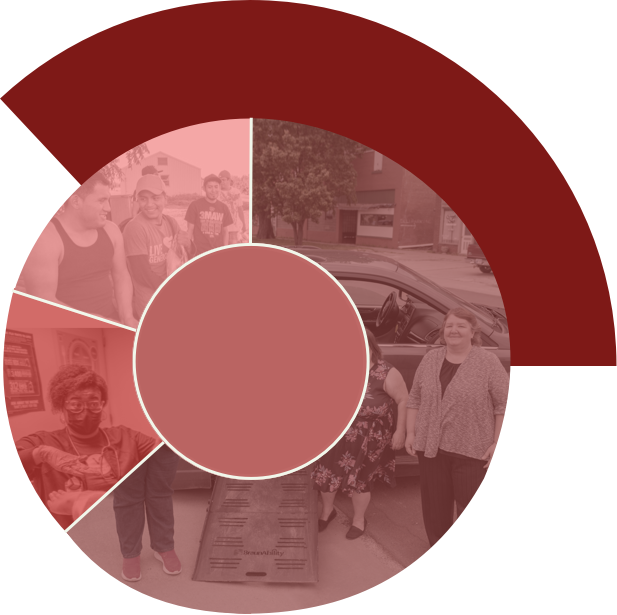



As part of our mission to advance health equity in our region, the REACH Foundation Board of Directors and staff make professional and personal development a core part of how we operate. The past year was no exception – 2022 represented our deepest dive yet into the damaging and long-term effects of racism on health outcomes, the phenomenon of unconscious bias and the role it plays in the health care delivery system, as well as the consequences of our own interpersonal behaviors and actions.
Board and staff discussions that occurred over the year encompassed the history of redlining and how its artifacts found their way into the ways in which philanthropy operates, including the operating approaches of REACH.
This reflection, while necessary, can be painful. The REACH Board and our staff spent time in conversation reflecting on the longstanding rules and practices we leaned on that, intentionally or not, kept out organizations in our community that were best positioned to understand and address population health and social determinants of health. The net effect was that some of our practices left a number of organizations in the position of pursuing their missions with less access to resources that would have enhanced their efforts.
It’s gratifying to work with a Board of Directors that embraces these kinds of conversations and urges staff to unwind practices that were never fair. Staff has been actively examining and dismantling grantmaking requirements that discouraged people from approaching REACH. Those efforts began before the pandemic but gained momentum with our mission-focused discussions over the prior year.
REACH is now in the second year of a strategic plan with a revised Community Investment Framework that places health equity firmly at the center. It’s the lens through which we view our purpose and responsibility. Streamlining grant applications, dropping unnecessary documents, reducing wait times on grant decisions, and minimizing reporting requirements are just a few of the changes now baked into our system.
REACH’s portfolio of core operating grants, the largest portion of our annual grantmaking budget, expanded at the end of 2022 to include multi-year core partner grants and additional core partners led by Black and Brown leaders who are deeply rooted in community. In 2023, we’re introducing other responsive philanthropy practices and funding opportunities to support emerging nonprofits serving Black, Brown, Immigrant and Refugee and rural populations, and supporting regional efforts to increase diversity in the region’s health and human services sector.
Changes in our total reported grantmaking for 2022 were due to reduction in pandemic-response grants and a limited scope project to act as a sub-grantee for mental health and substance use treatment resources on behalf of Johnson County Government. We welcome those opportunities to support local government.
We hope readers of our 2022 annual report will be inspired by this work and lend their talents to one or more of the many outstanding REACH partners highlighted within. Quality health care and access to affordable coverage are the rights of all, not just the few that are well-served today.
Lynette Sparkman-Barnes, REACH Board President
Brenda Sharpe, President & CEO
REACH uses a community investment framework centered on three outcome areas that support equitable health outcomes. Each area is defined by strategies that drive our work, partnerships and where we invest. These outcome areas were introduced in 2022 with the launch of a new five-year strategic plan. They reflect enduring commitments to health coverage and the health care safety net, as well as evolving interests, such as equity in leadership development and a diverse health care workforce.

Strengthen the Safety Net comprises the largest allocation of funding. Within this outcome area, 17 health care, advocacy and policy, and Black- and Latinx-led nonprofits were awarded unrestricted core partner grants, totaling $1.7 million. Other funding supported development of a multi-agency plan to help community mental health agencies prepare for implementation of the 988 mental health crisis response system.

Grants within this outcome area aim to advance health equity by strengthening leadership and capacity of organizations addressing social determinants of health. Five Black-led nonprofits were awarded $20,000 grants through the Centering Black Voices pilot. A $40,000 grant to the Greater Kansas City Chamber of Commerce supported a metro-wide effort to implement a Welcoming KC region plan to address inclusion of immigrants and refugees.

REACH continued to support advocacy, policy research and voter education, including $165,200 in grants to The Voter Network, an affiliate of Mainstream Coalition, and ACLU Foundation of Kansas as part of an ongoing integrated voter engagement initiative. REACH awarded 14 Building Connections to Coverage and Care grants totaling $580,000 to support health care connector and health navigation and enrollment assistance throughout the foundation’s service area.

REACH awarded 39 grants in this area to provide for professional development and training, such as Mental Health First Aid, interprofessional education for health care providers, and annual holiday contributions to nonprofit organizations in each of the REACH service area counties.
Working to close health equity gaps, including in the rural parts of the REACH service area, the foundation awarded eight grants to public health departments, mental health services and youth mental health education programs, a dental program serving migrant farmworkers, and a technology-based program to address the health of underserved pregnant individuals and their infants in rural areas. These investments included new grantees and longstanding partners leading health innovations in Cass and Lafayette counties, MO, and Allen County, KS.
8 Grants
REACH increased its investment in the Centering Black Voices leadership development pilot that was first introduced in 2021. In 2022, five organizations received second year general support grants of $20,000, along with three organizations that were funded in 2021. REACH staff continued to explore other avenues for relationship-building with Black-led nonprofit organizations, including grantee learning and social networking events specifically for Black nonprofit leaders, and expanding the foundation’s core partner cohort to include seven Black- and Latinx-led nonprofits.
8 Grants
“The REACH Foundation’s Community Investment Framework places health equity firmly at the center. It’s the lens through which we view our purpose, and directs us to be more deliberate in engaging leaders in Black and Latinx communities, as well as immigrant- and refugee-serving and rural-based organizations to ensure we’re partnering with people who are most deeply affected by persistent inequities in our health care systems.”
2022 marked the rollout of a new community investment framework to guide grantmaking and other funding priorities for the next five years.
While the REACH Foundation’s investment performance reflected the declines seen by investors across the country, REACH maintained its commitment to the mission and health equity priorities during the year.

The REACH Foundation is governed by a 17-member board of directors who reside within the foundation’s six-county service area. REACH Board members bring diverse demographic and life experiences, passion for the communities where they live and work, and governance, civic, nonprofit and business expertise.
The REACH Foundation’s assets totaled $135 million at year-end 2022, with an annual investment return of -13.5% for the foundation’s portfolio.
The investment performance losses in 2022 were notable – but consistent with investment outcomes in the larger economy. Since REACH’s inception, the investment return for the foundation was +5.8% through December 31, 2022.
Since the first year of grantmaking in 2005, REACH has invested nearly $82 million in direct grants, technical assistance and convening to advance the foundation’s mission within the six-county service area. Beyond these direct investments, REACH has allocated an additional $16 million in indirect investments via personnel and miscellaneous support. Together, these direct and indirect mission-related investments represented nearly 90% of the foundation’s total spending since 2005.

